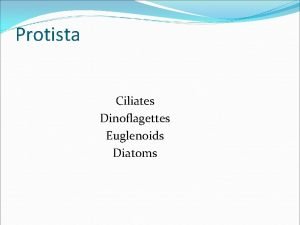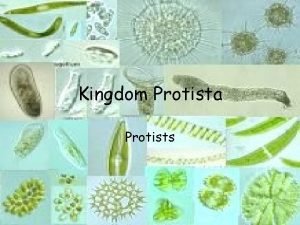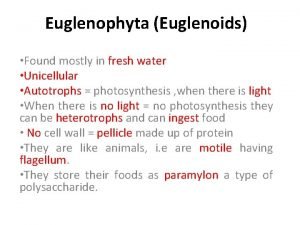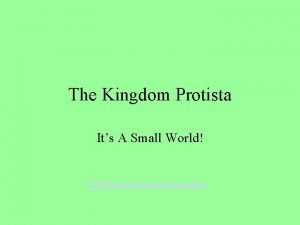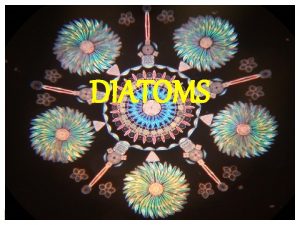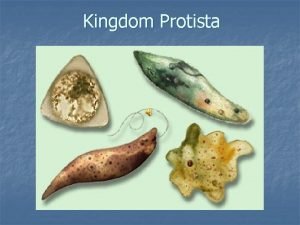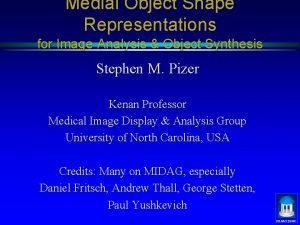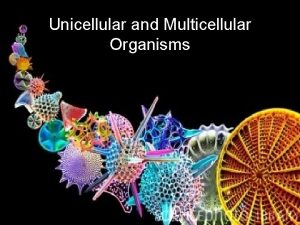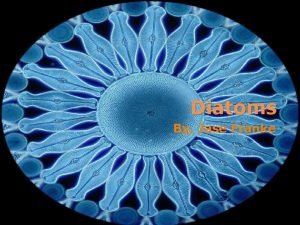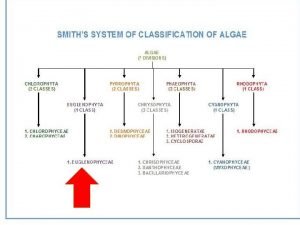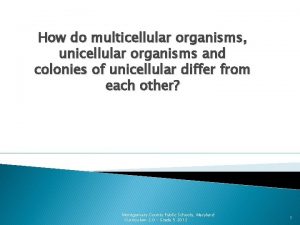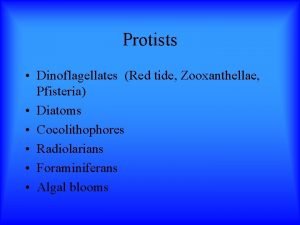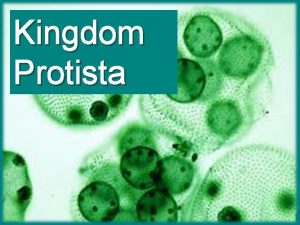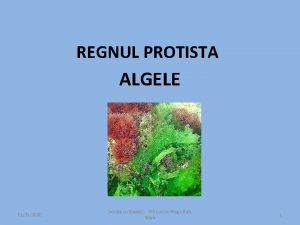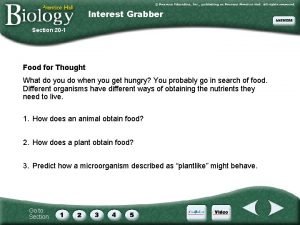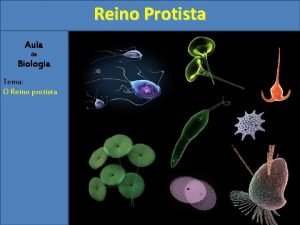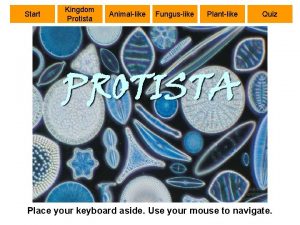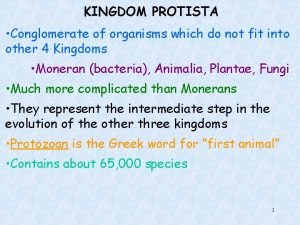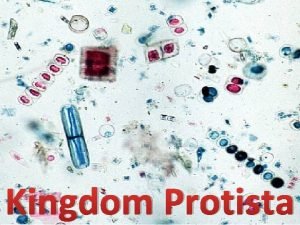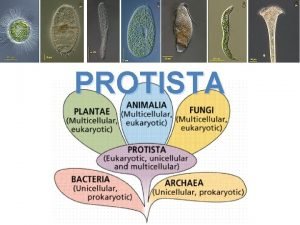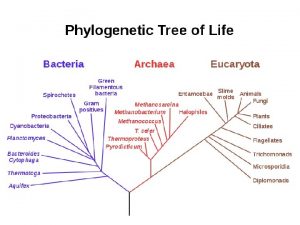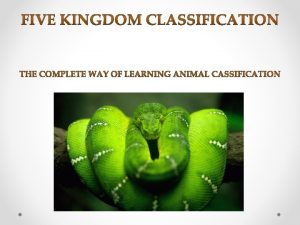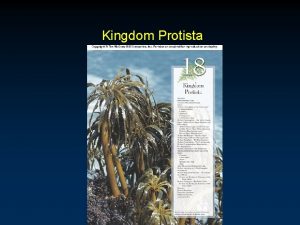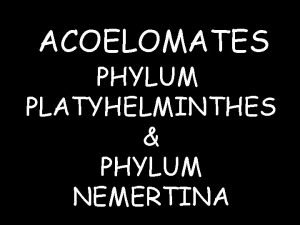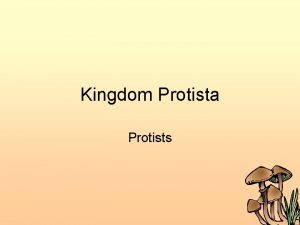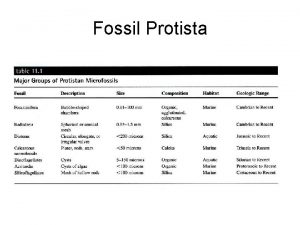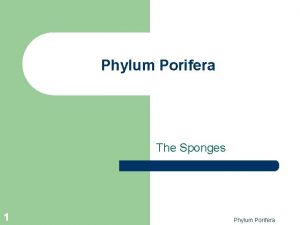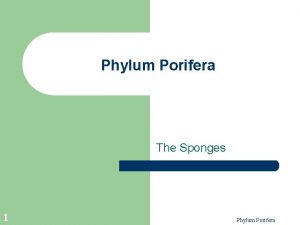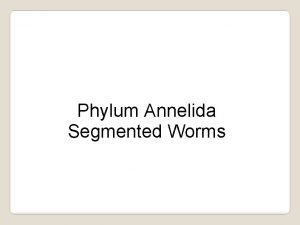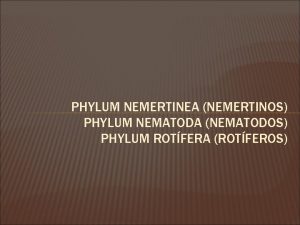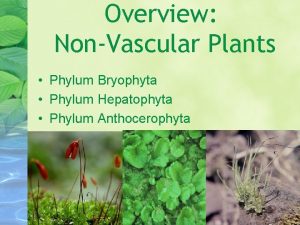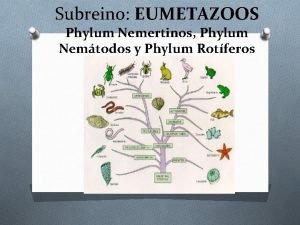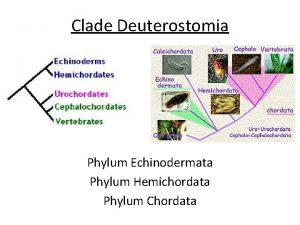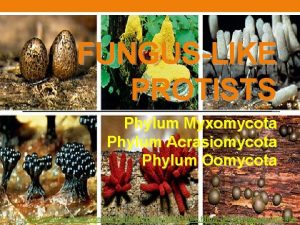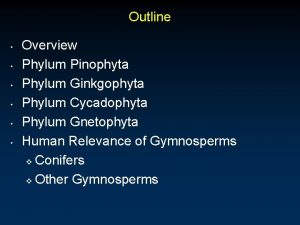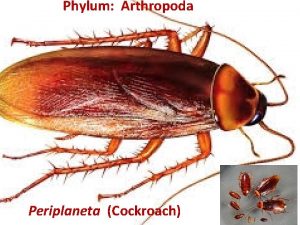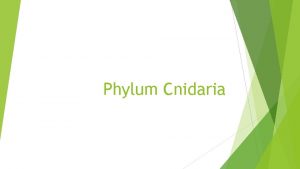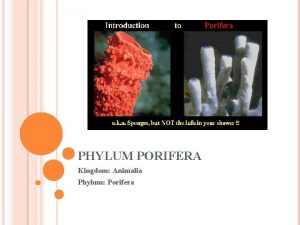Protista Ciliates Dinoflagettes Euglenoids Diatoms Ciliates Phylum Ciliphora




























- Slides: 28

Protista Ciliates Dinoflagettes Euglenoids Diatoms

Ciliates Phylum – Ciliphora 8000 estimated speicies 8 classes Prostomatea Litostomatea Karyorelictida Spirotrichea Phyllopharyngea Passophorea Oligohymenophora Colodea

Important Stuff Surface Called the Pellicle Flexible. The ciliate is able to change shape Covered in Cilia Latin for “eyelash” Hair-like Fused into sheet-like membranes Used to sweep in food Thick bundles called Cirri Used to walk through nerve-like endings Neurofibrils

Nuclei Two Macronucleus Routine cellular function Divides by splitting in two Micronucleus Contains chromosomes Divides by mitosis

Vacuoles Food Vacuoles Enzymes break down food Contractile Vacuole Regulate water levels Collect water, then sqeenze Star shaped Each point in a collection tube Only freshwater ciliates have them

Food Heterotrophs Can't make own food Mouth Pore Swept through by oral cilia To the Gullet Food vacuoles are made here Enzymes help break down food

Reproduction Usually asexual Eventually die out after 700 generations Conjunction Attach at mouth pore Form a bridge between cells Macronuclei disintegrates Exchanged through bridge Micronuclei divides by meiosis

Dinoflagellates Phylum - Dinoflagellata Means “whirling flagella” Roughly 2, 100 species

Photosynthesis About half are photosynthetic Make own food using sunlight Food source for others Others feed on other protists or diatoms Noctiulca is large enough to eat fish eggs

Bioluminescense Produce own light Chemcial reaction Luciferin is oxidized by ATP, Oxygen, and Luciferase Brighten when agitated First seen in Noctiluca

Flagella Clusters of protein strands One lies in a groove called the Sulcus Beats back and forth to propel One lies in a groove called the Cingulum Allows to turn and maneuver

Armor Covering is called the Amphiesma Flattened vesicles in between two membranes Contain Thecal Plates Two main regions 2 -100 plates in each region Edges overlap and slid as the cell grows Ridges or Crests Some crests are hallow House bacteria Provide nitrogen

Organelles Nucleus Fills half the volume of the cell 12 -400 chromosomes attach to the nuclear membrane Membrane doesn't break down when it divides Microtubules permeate the nucleus Coordinate the segregation of chromosomes Condense during mitosis and interphase Unwind for DNA Replication Trichocysts Defense mechanis

Eyespots Most photosynthetic dinoflagellates have them Light sensitive organells Lipid droplets in layers of membranes Carotenoids Compounds that allow the dinoflagellate to detect the direction of light Ocellus Complex structure Uses a lens to focus on an image Rare species have this

Reproduction • Asexual reproduction • Red Tide – Reproduce quickly and in great numbers • More than 20 million dinoflagellates per liter or sea water – Water appears to have a red color • Neurotoxin Produced – Most common is Saxitoxin – Brevitoxin is another

More On Toxins • Saxitoxin – 100, 000 x more potent than cocaine – Normally found in • • Protogonyaulax Catenella Gessnerium Monilatum – Affects muscle function – PSP (Paralytic Shellfish Poisoning) • Death from respitory failure • Brevitoxin – Kills fish – Humans eat the fish, resulting in human poisoning • • Ciguatera NSP (Neurotoxic Shellfish Poisoning) – Rule of thumb: • Only eat Shellfish during months with an “R”

Euglenoids • Phylum – Euglenophyta • Over 1, 000 species

Reproduction Asexual reproduction Sexual reproduction is unheard of in euglenoids Reproduce through Mitosis and Cytokinesis The nucleus undergoes mitosis Order of Operations Flagella root system replicates first Feeding apparatus second Pellicle last

Flagella Just like those seen in Dinoflagellates Most Euglenoids have two flagella Tetreutreptia has four Photosynthetic Euglenoids One flagella emerges, the other does not Very short and hidden inside the Flagellum Pocket

Pellicle Cell surface Arranged with ridges and grooves in strips Up and down, or in spirals Spiral euglenoids are capable of Metaboly A kind of wiggling motion that allows them to scoot by changing shape

Parts Chloroplasts Supposedly aquired Endosymbiosis of a green algal cell Eyespot / Stigma Carotenoids Detect the direction and intensity of light Nucleus Near the center of the cell Nucleolus or multiple nucleoli

Diatoms Phylum Bacillariophyta 11, 000 species Found: Oceans Lakes Ponds Streams WATER!!

Photosynthesis Diatoms are photosynthetic Food producers Use Carbon Fixation Convert carbon dioxide and water to light energy Major source of atmospheric oxygen 20 – 25% of oxygen comes from them

Skeletons One line down the middle that allows the cell to split Two Parts Called Valves Hypotheca Epivalve Overlaps the hypotheca Act like the lid of a box Highly perforated so things can go in and out

Different Types Centrale Diatoms Radially symmetrical from a central point Round, with the same pattern all around Pennale Diatoms Bilateral symmetry (split down the middle) Slit called the Raphe Creates Mucilage Attach to things to allow movement by gliding Domoic Acid Absorbed in mussels and makes them unsafe to eat A domoic crazed seagull is said to be the inspiration behind The Birds

Reproduction Sexual – only during times of stress During cell division, eggs or sperm are made Fertilization Free-swimming sperm finds eggs inside a female cell Auxospore The cell grows Test Secretion The cell returns to asexual mode Asexual Cell division Get smaller with each division

Review Ciliates Asexual or sexual reproduction Cilia to move around Two nuclei Dinoflagellates Red Tide Two flagella Bioluminescense Euglenoids Asexual reproduction One short flagella Metaboly movement Diatoms Sexual reproduction during stressful times Huge producers of oxygen Intricate skeletons

Sources http: //www. ucmp. berkeley. edu/protista/dinoflagellata. html http: //www. microscopyuk. org. uk/mag/indexmag. html? http: //www. microscopyuk. org. uk/mag/wimsmall/cilidr. html http: //en. wikipedia. org/wiki/Ciliate#Feeding http: //www. ucmp. berkeley. edu/protista/dinoflagellata. html http: //www. assurecontrols. com/info-dinoflagellates. htm http: //en. wikipedia. org/wiki/Saxitoxin#Human_illness http: //www. nmfs. noaa. gov/pr/pdfs/health/brevetoxin. pdf http: //silicasecchidisk. conncoll. edu/Lucid. Keys/Carolina_Key/html/Euglenoi ds. html http: //euglena. msu. edu/ http: //tolweb. org/Euglenida/97461 http: //www. ucmp. berkeley. edu/chromista/bacillariophyta. html http: //www. mbari. org/staff/conn/botany/diatoms/john/basics/repro. htm
 Ciliphora
Ciliphora Protista
Protista Diatoms unicellular or multicellular
Diatoms unicellular or multicellular Euglenophyta (euglenoids)
Euglenophyta (euglenoids) Ciri protista
Ciri protista Baccilariophyta
Baccilariophyta What is a plant like protist
What is a plant like protist Characteristics of diatom
Characteristics of diatom Diatoms kingdom
Diatoms kingdom Diatoms
Diatoms Is algae unicellular or multicellular
Is algae unicellular or multicellular Diatom domain and kingdom
Diatom domain and kingdom Tubulinids characteristics
Tubulinids characteristics Characteristics of euglenophyta
Characteristics of euglenophyta Multicellular organisms
Multicellular organisms The alveolates that cause red tides are
The alveolates that cause red tides are Protist volvox
Protist volvox Protista distinguishing characteristics
Protista distinguishing characteristics Regnul protista
Regnul protista Section 20-1 the kingdom protista
Section 20-1 the kingdom protista Reino protista
Reino protista Quiz 3: plant- and fungus-like protists
Quiz 3: plant- and fungus-like protists Pseudopodia
Pseudopodia Characteristics of kingdom protista
Characteristics of kingdom protista Protista
Protista Animalia plantae
Animalia plantae Divisão das algas
Divisão das algas Eukarya protista
Eukarya protista Classification of protista
Classification of protista
